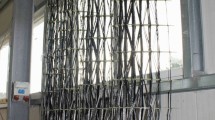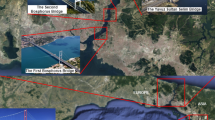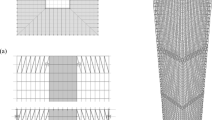Abstract
Floating offshore wind (FOW) requires cost reduction to compete with fixed offshore wind, and other traditional and renewable energy sources. One major cost contributor in FOW is the mooring system. Volume effects are expected to deliver significant savings for most cost drivers, but moorings are already produced at scale and at volume for the oil and gas sector, and innovation is required to address the specific challenges of FOW. This paper investigates the use of Dublin Offshore’s load reduction device (LRD) integrated with high-modulus synthetic mooring lines in an inclined taut mooring (ITM) configuration for semi-submersible station kee**. The ITM comprises a 3-line array with vertically loaded anchors within a reduced mooring footprint, fully synthetic Dyneema® DM20 mooring lines, and optimized system compliance provided through an in-line LRD on each mooring line. The ITM allows mooring designers to significantly reduce component count, risk of failure, CAPEX, and lifetime cost of the mooring system. Wave tank testing was carried out at 1:60 scale using a variant of the TetraSub, a market-ready 15 MW semi-submersible FOW platform, developed by Stiesdal Offshore Technologies (SOT) at the Offshore Basin in MARIN in Q3 2021. The experimental results of wave tank testing presented in this paper demonstrate the feasibility of the innovative ITM mooring configuration. In addition, good agreement is observed between LRD quasi-static performance and each of the numerical analysis in OrcaFlex, and the wave tank testing results.


























Similar content being viewed by others
Data availability
All material is the original work of the authors and owned by the authors. The testing and analysis data generated within the study are presented in this paper. Commercially sensitive data have not been presented. Additional data are available on request.
Abbreviations
- COB:
-
Centre of buoyancy
- COG:
-
Centre of gravity
- γ:
-
Peak enhancement factor
- H:
-
Wave height regular wave
- Hs :
-
Significant wave height
- HMPE:
-
High modulus polyethylene
- FOW:
-
Floating offshore wind
- GM(t):
-
Transverse metacentric height
- ITM:
-
Inclined taut mooring
- LRD:
-
Load reduction device
- RNA:
-
Rotor nacelle assembly
- SOT:
-
Stiesdal offshore technologies
- SWL:
-
Safe working load
- SS:
-
SeaState
- T:
-
Wave period regular wave
- Tp :
-
Wave peak period irregular wave
- TRL:
-
Technology readiness level
References
Bosman R, Zhang Q, Leao A, Godreau C (2020) First class certification on HMPE fiber ropes for permanent floating wind turbine mooring system. In: Proceedings of the Offshore Technology Conference, Houston, Texas, USA 2020. https://doi.org/10.4043/30475-MS
Carbon Trust (2018) Floating Wind Joint Industry Project Phase 1 Summary Report. May 2018 pp 42–50. https://ctprodstorageaccountp.blob.core.windows.net/prod-drupal-files/documents/resource/public/Floating%20Wind%20Joint%20Industry%20Project%20-%20Summary%20Report%20Phase%201%20REPORT.pdf
Corewind (2019) Corewind Deliverable 1.2 Design Basis. December 2019. https://corewind.eu/wp-content/uploads/files/publications/COREWIND-D1.2-03-Design-Basis.pdf
DNV (2020) Floating wind: the power to commercialize. December 2020 pp 4–5 https://www.dnv.com/focus-areas/floating-offshore-wind/commercialize-floating-wind-report.html
Doyle T, Golden D, Hayes D (2021a) Introducing the LRD, a passive load reduction device for floating wind. Presented at floating offshore wind turbines conference, St Malo, France November 2021. https://www.researchgate.net/publication/357017723_Introducing_the_LRD_a_passive_Load_Reduction_Device_for_Floating_Wind_Dr_Tom_Doyle_Dublin_Offshore
Doyle T, Golden D, Hayes D, Carr D (2021b) The use of non-linear mooring response for improved FOW lifecycle performance. Poster presented at the International Conference on Ocean Energy, April 2021 https://www.researchgate.net/publication/351124520_The_use_of_non-linear_mooring_response_for_improved_FOW_lifecycle_performance_Methodology
InnoEnergy (2017) Floating Offshore. 55 technology innovations that will have greater impact on reducing the cost of electricity from European floating offshore wind farms. pp 56–59 ISBN: 978-84-09-05326-1
Leblans P, Bastiaansen C, Govaert L (1989) Viscoelastic properties of UHMW-PE fibers in simple elongation. J Polym Sci Part B Polymer Physics 27:1009–1016. https://doi.org/10.1002/polb.1989.090270504
McEvoy P, Johnston E (2019) Polymer mooring component for offshore renewable energy. In: Proceedings of the Offshore Technology Conference, Houston, Texas, USA 2019. https://doi.org/10.4043/29587-MS
McEvoy P, Kim S, Haynes M (2021) Fibre spring mooring solution for mooring floating wind turbines in shallow water. In: Proceedings of the Int Conf on Offshore Mechanics and Arctic Engineering (virtual) June 2021 https://doi.org/10.1115/OMAE2021-62892
Stiesdal Offshore Technologies (2021) Tetra floating offshore foundations, accessed March 23, 2023, https://www.stiesdal.com/wp-content/uploads/2021/11/30883-Stiesdal-Offshore-Technologies-brochure.pdf
Acknowledgements
The authors would like to acknowledge the staff at MARIN for their support during testing.
The authors would like to thank the Marinet2 Transnational Access Programme for supporting the test campaign.
Funding
This project has received funding from the European Union’s Horizon 2020 research and innovation programme under grant agreement number 731084. This Horizon2020 funding was received through the Marinet2 Transnational Access Programme. No other funding was received. Danny Golden, Tom Doyle and David Carr of Dublin Offshore have contributed the design and oversight of the testing campaign, the numerical analysis of results, and the primary authoring of the paper. Rigo Bosman of Avient has contributed detailed technical review of the test campaign and paper and specifications for the mooring line. Michael Borg of Stiesdal has contributed detailed analysis of the semi-sub platform, and detailed technical review of the test campaign and paper.
Author information
Authors and Affiliations
Contributions
Danny Golden, Tom Doyle and David Carr of Dublin Offshore have contributed the design and oversight of the testing campaign, the numerical analysis of results, and the primary authoring of the paper. Rigo Bosman of Avient has contributed detailed technical review of the test campaign and paper and specifications for the mooring line. Michael Borg of Stiesdal has contributed detailed analysis of the semi-sub platform, and detailed technical review of the test campaign and paper.
Corresponding author
Ethics declarations
Conflict of interest
The authors confirm no conflict of interest.
Additional information
Publisher's Note
Springer Nature remains neutral with regard to jurisdictional claims in published maps and institutional affiliations.
Rights and permissions
Springer Nature or its licensor (e.g. a society or other partner) holds exclusive rights to this article under a publishing agreement with the author(s) or other rightsholder(s); author self-archiving of the accepted manuscript version of this article is solely governed by the terms of such publishing agreement and applicable law.
About this article
Cite this article
Golden, D., Doyle, T., Borg, M. et al. An investigation into the use of load reduction devices integrated with high-modulus synthetic mooring lines for semi-submersible station kee**. J. Ocean Eng. Mar. Energy 10, 475–488 (2024). https://doi.org/10.1007/s40722-024-00323-3
Received:
Accepted:
Published:
Issue Date:
DOI: https://doi.org/10.1007/s40722-024-00323-3




